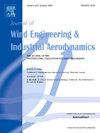下爆风诱导的风沙运动对高架桥上列车气动特性的影响
IF 4.9
2区 工程技术
Q1 ENGINEERING, CIVIL
Journal of Wind Engineering and Industrial Aerodynamics
Pub Date : 2025-06-02
DOI:10.1016/j.jweia.2025.106135
引用次数: 0
摘要
雷暴降暴作为一种强烈的下沉气流,容易引发对流沙尘暴,严重影响高速列车在桥上运行的安全。首先,采用冲击射流模型模拟下爆风场,利用非线性最小二乘拟合得到垂直风速廓线;然后,将这些剖面与入口条件相结合,诱导沙尘运动,形成沙尘暴环境。最后,采用离散相模型(DPM)分析了径向距离和沙粒直径对高温超导气动特性的影响。结果表明,砂浓度随径向距离先升高后降低,随粒径增大而持续升高;由于侧风的影响起主导作用,压力系数的变化对径向距离的敏感性大于对沙粒直径的敏感性。在加砂和不加砂的不同工况下,阻力系数(CX)、侧向力系数(CZ)和倾覆力矩系数(CMX)在径向距离r = 1.0 Djet时差异最大,分别为6.63%、5.02%和3.47%。升力系数(CY)在径向距离r = 0.5 Djet时差异最大,达6.10%。当径向距离r = 1.0 Djet时,随着砂径从0.05 mm增加到0.5 mm,整个列车的CX、CY、CZ和CMX分别增加了87.09%、5.16%、3.95%和6.01%。本文章由计算机程序翻译,如有差异,请以英文原文为准。
Influence of wind-blown sand movement induced by downburst wind on aerodynamic characteristics of a train running on viaduct
As a strong sinking airflow, thunderstorm downbursts are prone to cause convective sandstorms, seriously affecting the safety of high-speed trains (HST) running on bridges. Firstly, an impinging jet flow model was used to simulate the downburst wind field, and nonlinear least-squares fitting was applied to obtain vertical wind velocity profiles from the simulation results. Then, these profiles were combined with inlet conditions to induce sand movement, creating a sandstorm environment. Finally, the discrete phase model (DPM) was applied to analyze the effects of radial distance and sand particle diameter on the HST aerodynamic characteristics. The results indicated that sand concentrations initially increased and then decreased with radial distance, while they consistently increased with larger particle diameters. Since the effect of crosswinds played a dominant role, variations in the pressure coefficient were more sensitive to radial distance than to sand diameter. Furthermore, under different conditions with and without sand, the drag force coefficient (CX), lateral force coefficient (CZ), and overturning moment coefficient (CMX) exhibited the most significant differences at radial distance r = 1.0 Djet, with 6.63 %, 5.02 %, and 3.47 %, respectively. For the lift force coefficient (CY), the maximum difference of 6.10 % occurred at a radial distance of r = 0.5 Djet. Additionally, as the sand diameter increased from 0.05 mm to 0.5 mm at r = 1.0 Djet, CX, CY, CZ, and CMX of the entire train increased by 87.09 %, 5.16 %, 3.95 %, and 6.01 %, respectively, under radial distance r = 1.0 Djet.
求助全文
通过发布文献求助,成功后即可免费获取论文全文。
去求助
来源期刊
CiteScore
8.90
自引率
22.90%
发文量
306
审稿时长
4.4 months
期刊介绍:
The objective of the journal is to provide a means for the publication and interchange of information, on an international basis, on all those aspects of wind engineering that are included in the activities of the International Association for Wind Engineering http://www.iawe.org/. These are: social and economic impact of wind effects; wind characteristics and structure, local wind environments, wind loads and structural response, diffusion, pollutant dispersion and matter transport, wind effects on building heat loss and ventilation, wind effects on transport systems, aerodynamic aspects of wind energy generation, and codification of wind effects.
Papers on these subjects describing full-scale measurements, wind-tunnel simulation studies, computational or theoretical methods are published, as well as papers dealing with the development of techniques and apparatus for wind engineering experiments.

 求助内容:
求助内容: 应助结果提醒方式:
应助结果提醒方式:


